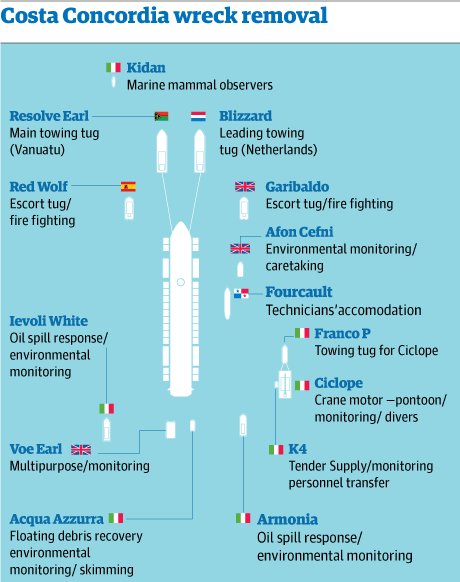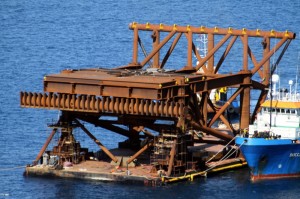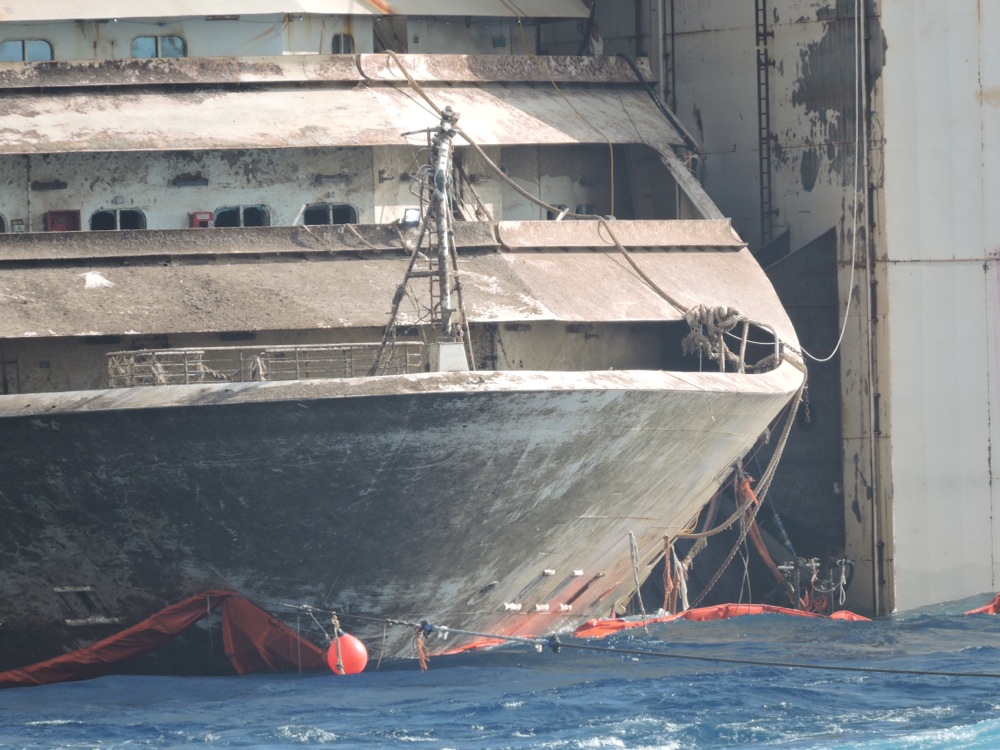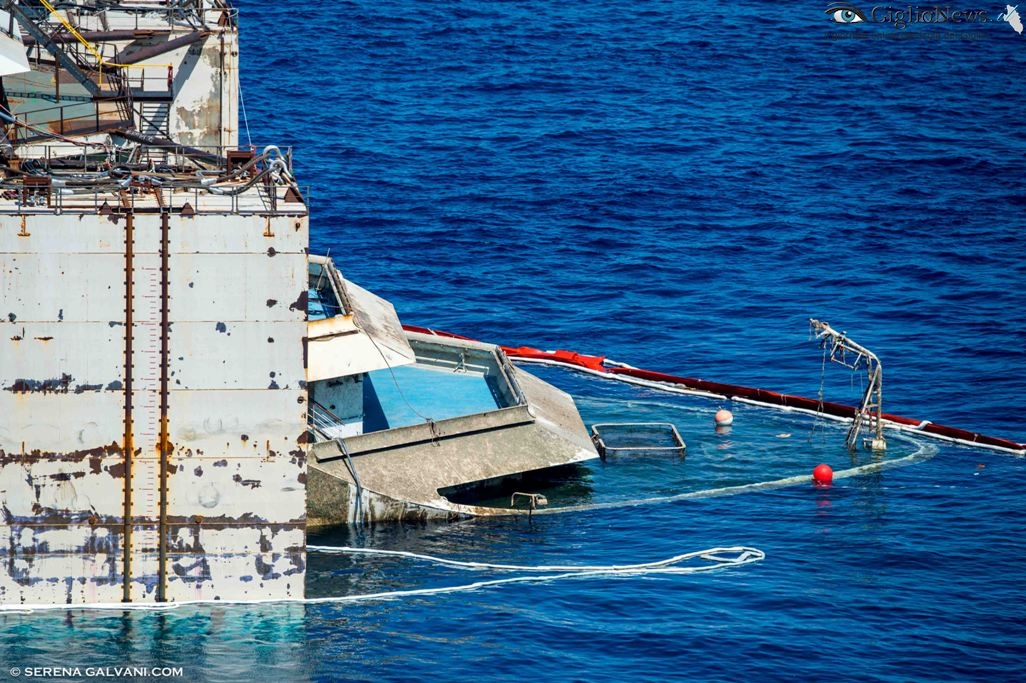
Ken711
-
Posts
315 -
Joined
Content Type
Forums
Store
Blogs
Downloads
Events
Gallery
Posts posted by Ken711
-
-
I amazed that the top deck can support the weight of that one truck mounted crane shown in the aerial video.
-
The people of Giglio vote to keep platforms; will gov't agree?:
I had a feeling they would.
-
The scrapping process will look to deal with three major groups in order of precedence:
Hazardous materials: Since this is being done in a country where there are environmental regulations, all hazmat will be identified, and removed first, where possible. Hazmat crews will work from top down to prepare the decks for the follow on workers.
High value materials: mainly the copper in the miles of wiring. Again, starting at the top, the passageway ceiling panels will be removed, to gain access, and the wiring will be cut at fixtures and cabins, and pulled out.
Everything else.
They will most likely cut the top deck off, opening the rooms below to access, and strip out public spaces of things like joiner bulkheads (the walls you see) to gain access to wiring for removal. Then flammables like carpeting will be removed (if not removed in the hazmat stage due to mold). Cut that deck off and set ashore for further deconstruction (sorting the metal from the other materials and cutting to smaller bits). Repeat. With the cabins, they will use cutters, grinders, saws, and torches to cut the wiring and piping, and lift the cabins out whole for deconstruction ashore and recycling. Since everything is going for recycling or scrap, they are not real careful, more slash and burn. Machinery spaces take a bit longer, as there are more high value items there (much more wiring, motors with copper, etc), and the engines to be broken up for component metals.
Again, given that this is being done in Italy, there will be quite a lot of deconstruction and sorting of materials done off the ship, where it can be controlled, is safer for the workers, and is cheaper.
Cheng thanks for the process description. Any guess on how long this will take?
-
Ropes used in parbuckling.
Dyneema ropes fundamental for ‘Concordia’ parbuckling15 Aug 2014
The ‘Costa Concordia’ parbuckling operation on the rocks of the Italian island of Giglio has been a success in many ways. High performance ropes with Dyneema played a key role in the operation, according to Netherlands based DSM Dyneema.
The Titan-Micoperi salvage partnership realised early on that any ropes required for the creation of the holdback system, to hold the wreck in place and then help bring it upright, would rub along the sea floor. It was imperative that any further damage to the ecosystem, beyond that caused by the ship itself running aground, be kept to a minimum. For this reason, the decision was made to go for a rope system that is not only extremely strong, but also very light and easy to handle. As Dyneema has neutral buoyancy in water, the ropes are easy to pull through the water by divers.
During the installation process, the ropes with Dyneema did indeed not drag along the seabed as steel ropes would have done. Nevertheless, since they are in constant contact along much of their length with the hull of the ship, they need surface protection, which is why Dextron 12 Plus ropes with patented protective jackets from leading Norwegian rope maker Offshore and Trawl Supply (OTS) were chosen. The covers for the Costa Concordia project also contained a reflective additive so that they could easily be seen by divers working in the dark.
In all, there were 22 Dextron 12 Plus ropes holding the Costa Concordia, two running from each of the 11 towers mounted on the sea floor along the starboard (shore-side) side of the ship and connecting to chains that ran under the hull and which were attached to the far (port) side. All the ropes had the same diameter, but each had a different length, of between 40 and 55 meters.
Since the ropes were to be loaded for a prolonged period of time, creep had to be considered. Among the various types of HMPE fiber on the market today, Dyneema has been demonstrated to creep the least, and by a significant factor.
Marc Eijssen, Senior Application Manager, Offshore & Industrial at DSM Dyneema, says the company carried out a series of creep evaluations using its in-house model to predict creep under a variety of load and temperature scenarios. Based on these models, Titan-Micoperi and OTS were able to calculate the exact length needed for each rope. As is clear to see, the model proved accurate, and the parbuckling operation went exactly according to plan.
By Jake Frith
-
Just looked at the Genoa cam and it looks like a crane is working there.
(Wish they could improve the view with that cam.)
Are you viewing it here?
-
From AOL.com news:
The Concordia was towed from its Tuscan graveyard last month to Genoa's port where it will be turned into scrap. During a search of the ship Wednesday, authorities found some bone fragments that they said could belong to the one person still unaccounted for from the tragedy: Indian waiter Russel Rebello. They said the bones could also belong to an Italian passenger whose partial, mutilated remains were found some months ago. -
Looked at the Giglio news parbuckling webcam and there seems a lot of activity going on. I wonder if they are starting to remove all the grout bags.
-
-
Hi Ken ... Not seen anything story wise about any work being carried out there before the arrival of CC, as it looks like a container port it may be that the area was already at a depth to take the ship.
Thanks. What a successful salvage engineering feat.
-
Does anyone know if they had to dredge the area next to the breakwater where the CC is moored to accommodate the deeper draft she has with the sponsons?
-
CC has come full circle from the port where she was built to the port where she will be taken apart. Kind of sad in a way. :(
-
I think more powerful zoom lens on the camera made it appear closer.
-
I'm using Marine Traffic:
http://www.marinetraffic.com/en/ais/home/centerx:10.67274/centery:42.4896/zoom:8/mmsi:244495000
When you go on you can close out the box that shows Blizzard.
Then I suggest you zoom in some. You'll see some little triangles leading from Giglio to Concordia.
Interesting when you click on the Costa Concordia details it shows the Draught as 18m.
-
Great overhead shots!
-
My live feed indicates a new course of West by southwest which will take them to the sea lane north to Genoa.
The sea lane is stradled by the French Isle of Corsica to the west and the Italian Isle of Elba to the east.
Thanks. I'm assuming if the weather forecast is favorable, they are looking for the quickest route?
-
The flotilla has made a 90 degree turn and is heading southwest. I wonder what's going on.
Still heading southwest?
-
-
-
Has anyone seen any photos showing the underwater platforms now with the CC off them?
-
Another image of the towing fleet

Also more pictures from inside the ship here:
http://www.businessinsider.com/photos-of-the-inside-of-the-sunken-costa-concordia-2014-7
Imagine how small the fleet would have been if the CC was loaded on the Vanguard. :)
-
How long do you think it will be before some one in Giglio comes up with the idea to build a full scale replica of the Concordia on the rock ledge as a tourist attraction, er uh, I mean a memorial ?

Not sure about the replica, but they are considering leaving the underwater platforms in place for a fish haven and underwater dive attraction. :D
The Group Minority Council Chamber Project Lily announces that it has submitted a request to the Mayor of the City Council with the agenda of two decisions, to be voted in respect of:1. Preservation Shipyard Concordia underwater platforms with consequent involvement of the various Authorities;
2. Publication Income and Balance Sheet, online, of Councillors and Councillors
We are certain the timely acceptance of our application in consideration of the very small time left to act before the contracting of works for the reclamation of the site Shipyard Concordia.
-
Pretty amazing to see her sitting in the water like this compared to when she was laying half submerged on her side for so long.

-
Some really good pix in this link.
And if you read the article, ignore the conversion of euro to dollar. :D
I expect there will be a correction to that.
~~~~~~~~~~~~~~~~~~~~~~~~~~~~~~~
John, parents spoil children. Grandparents indulge. :D
Nice photos SomeBeach thanks for the link.
-
This from yesterday.

Concordia News: Please Post Here
in Costa Cruises
Posted
Thanks, I didn't think the normal deck could support a crane plus the weight it would be lifting.